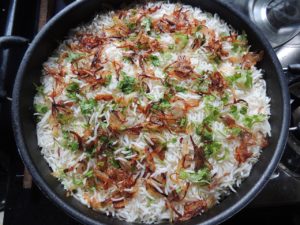“I love biriyani”
If health concerns have been holding you back from eating a biriyani, you’ve reached the right place! Because in this article, I’ll give you 7 tips that can help you make any biriyani, whether you buy it from a restaurant or you cook it at home, a healthy one. So are you ready?
If you like to watch videos than reading here is the video for the same article:
#1
Use vegetable oil like olive oil, canola oil, coconut oil. These oils differ in the amount of mono and polyunsaturated fatty acids and some of them are rich in saturated fatty acids.
Here in this article, I’ve written elaborately on how you can choose the right cooking oil.
#2
Never ever use vanaspati or solidified vegetable oils (e.g. Dalda) for cooking biriyani or any other food for that matter. It is prepared by the process of hydrogenation of vegetable oils and the thing to note here is that they contain high levels of trans fatty acids.
Trans fatty acids are notorious for causing coronary artery disease, stroke and other types of cardiovascular diseases. So, stay away from such cheap, but unhealthy cooking options.
#3
Ghee, on the other hand, is actually clarified butter. It is prepared by heating butter at 100-degree Celsius which evaporates the water content in it, leaving behind the most natural form of saturated fatty acids, that has been used even as medicines in India for more than 1000 years
Then why is it that everyone prefers vanaspati over ghee? Simply because it is cheap. Have you ever noticed the stickiness in your fingers while washing after eating that biriyani from the hotel? Yeah? That’s vanaspati, my friend. Avoid such restaurants for health sake!
So, now that you would have realized that preparing or cooking biriyani at home is the healthy option, right? You have control over what type of cooking oil is going to be used.
#4
Next up is the rice. Brown rice is better than whites rice when it comes to cooking biriyani too. Why? Because they have more fiber content, more micronutrients when compared to the usual white or polished rice.
I’ve already written an article on the differences between white rice and brown rice. You should definitely go read it if you haven’t already!
#5
Do not shallow or deep fry the meat before or while cooking biriyani. It’s simple logic! Frying increases the level of trans fatty acids and as such it is unhealthy. So it will be wiser to cook the meat “without frying” it. Search for “cooker biriyani” or “dum biriyani” recipes and you’ll find some good ones on the internet.
#6
Avoid the gravy or eat less of it. I know it’s tasty. But, you should understand that it is the oil content that is making the gravy the tastiest.
Do not be tempted to eat more than 2 chicken or other meat pieces! And limit the rice quantity to max one and a half cups.
#7
Make any biriyani healthier by adding more vegetables. I’m not talking about the curd, or chilies or onion salad that you get at restaurants along with biriyanis. Use carrots, cucumber, peas, and nuts to make it healthier and colorful!
Some bonus tips, just for you guys: 
- Do not buy fizzy soft drinks after eating biriyani. It’s not good for you
- Drink hot or cold water, whatever you like 30 minutes after eating the biriyani
- Avoid the pickle served together with biryanis
- Say no to papads along with biriyani
- Biriyani should not be used on a daily basis. Have it on on special occasion and make it a special one
So, there you have it! I hope you loved this article. Please do share it with your friends and family who love biriyani. Leave me any comments below. If you want to talk to me, download the Dofody app from Google Play Store. The first consultation is free for the awesome readers of “Being The Doctor”